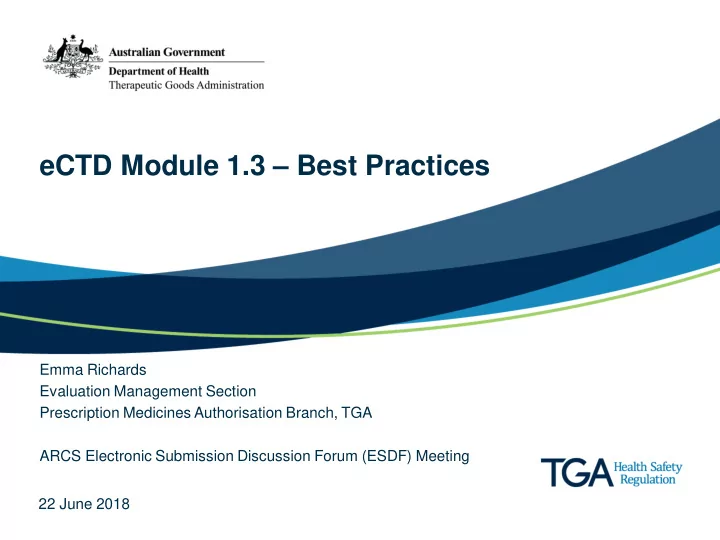

eCTD Module 1.3 – Best Practices Emma Richards Evaluation Management Section Prescription Medicines Authorisation Branch, TGA ARCS Electronic Submission Discussion Forum (ESDF) Meeting 22 June 2018
Presentation Overview • Module 1.3 Lifecycle Management Examples • Other Module 1.3 Considerations / Best Practice • Questions eCTD Module 1.3 – Best Practices 1
Reminder - Module 1.3 • Version 3.1 Module 1.3 layout. • New heading elements highlighted in yellow. • See eCTD AU module 1 and regional information V3.1 on the TGA website for further information. eCTD Module 1.3 – Best Practices 2
Module 1.3 Lifecycle – Initial PI, CMI and Labels • Initial sequence: – clean copies of the draft PI, CMI and labels within m1-3-1-1-pi-clean, m1-3-2-1- cmi-clean and m-1-3-3-1-mockup-clean using ‘new’ . • Response to request for information sequence: – amended clean copies using ‘replace’ . – annotated copies of the draft PI, CMI and labels within m1-3-1-2-pi-annotated, m1-3-2-2-cmi-annotated and m-1-3-3-2-mockup-annotated using ‘new’ . • Following negotiations: – amended clean and annotated copies using ‘replace’ . – ensure ALL amendments are included. Following Approval: • – ‘approved’ copies of the PI, CMI and labels within m1-3-1-3-pi-approved, m1-3-2- 3-cmi-approved and m-1-3-3-3-mockup-approved using ‘new’ . eCTD Module 1.3 – Best Practices 3
Further information on the ‘Approved’ folder • Should contain: – current Australian ‘approved’ versions of PI, CMI and labels . • Within eCTD: – provide the ‘approved’ versions as a post-approval closing sequence . sequence type Supplementary Information sequence description Product Information eCTD Module 1.3 – Best Practices 4
Module 1.3 Lifecycle Example - Changing the PI • Initial sequence of next submission: – clean copies of the draft PI within m1-3-1-1-pi-clean using ‘replace’ . – annotated copies of the draft PI within m1-3-1-2-pi-annotated using ‘replace’ . • No ‘approved’ PI is required as it was provided as part of the previous post- approval sequence. eCTD Module 1.3 – Best Practices 5
Module 1.3 Lifecycle Example - Concurrent change to the PI • Initial sequence of second submission: – clean copies of the draft PI within m1-3-1-1-pi-clean using ‘new’ . – annotated copies of the draft PI within m1-3-1-2-pi-annotated using ‘new’ . annotated version to include changes requested as part of this submission only. • Note that the operation ‘new’ will result in a validation warning: – justify validation warning within cover letter – indicate there are concurrent submissions – quote submission numbers eCTD Module 1.3 – Best Practices 6
Module 1.3 Lifecycle Example - Concurrent change to the PI Following Approval of 1 st PI change: • – clean copies of the ‘approved’ PI within m1-3-1-3-pi-approved using ‘replace’ . Following Approval of 2 nd PI change: • – clean copies of the ‘approved’ PI within m1-3-1-3-pi-approved using ‘replace’ . The ‘approved’ folder allows the TGA to track what changes have been finalized this is important when there are multiple changes within multiple submissions. eCTD Module 1.3 – Best Practices 7
Module 1.3 Lifecycle Example – Next change • Initial sequence next submission: – clean copies of the draft PI, CMI and labels within m1-3-1-1-pi-clean, m1-3-2-1-cmi-clean and m-1-3-3-1-mockup-clean using ‘replace’ . – annotated copies also provided using ‘ replace ’. • Recommend deletion of the other clean and annotated documents: – ‘ delete’ will result in validation warning. – justify this validation warning within the cover letter . To eCTD Module 1.3 – Best Practices 8
Considerations for Notifications • If a PI, CMI and/or label change is allowable as part of a Notification: – submit the ‘approved’ documents as part of the initial Notification sequence. – ensure clean and annotated documents are also included. Understanding Module 1.3 9
Considerations for transitioning from Module 1.3.3 • When using the updated regional specifications (Version 3.1), include labels within 1.3.3.1-mockup-clean, m1.3.3.2-mockup-annotated and m1.3.3.3- mockup-approved . • Within Version 3.0 of the regional specifications labels were included within 1.3.3-mockup. • Deletion of the labels from 1.3.3-mockup will result in an validation error . eCTD Module 1.3 – Best Practices 10
Electronic Submissions Update • New Electronic submission hub at https://www.tga.gov.au/electronic-submissions- and-data-review. • Update to the eCTD Document Matrix file download. • Automation of validation of sequences. • Transition period for the current regional specifications ends 30 June 2018. eCTD Module 1.3 – Best Practices 11
QUESTIONS? eCTD Module 1.3 – Best Practices 12
Recommend
More recommend